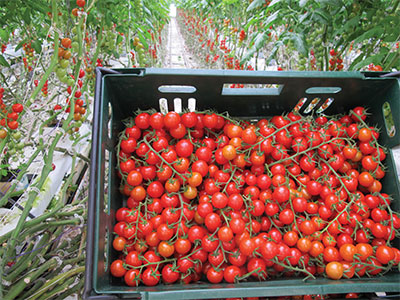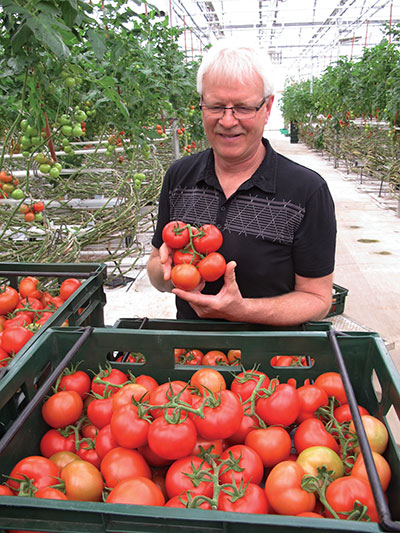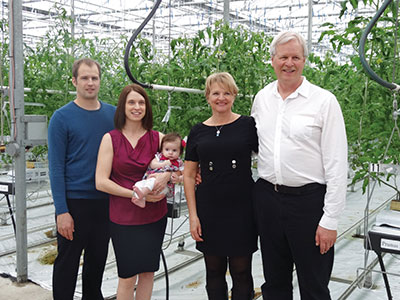
Variety is indeed the spice of life at Gull Valley Greenhouses, located just northwest of Red Deer, Alberta.
Variety is indeed the spice of life at Gull Valley Greenhouses, located just northwest of Red Deer, Alberta.
 |
|
| Ready for retail. |
This family business features 120,000 square feet of double poly production of tomatoes (about a dozen varieties), bell peppers (three colours), specialty peppers (minis and Palermo), beans (round and flat), and lettuce!
Oh, and some basil and mint.
Whew!
Gull Valley is as well known for its quality of produce as it is for its high level of diversification.
Phil and Carolyn Tiemstra appreciate the fact it’s truly a family business.
Son Levi is a partner with his parents in managing the farm.
Youngest daughter Francine assists most Saturdays at the Gull Valley stand in the Strathcona Farmers’ Market in Edmonton.
Son-in-law Scott Epple, husband of their daughter Jil, looks after their booth at the Calgary Farmers’ Market.
EARLY FARMING YEARS WERE WITH POULTRY OPERATION
As a young man, Phil was involved with his family’s poultry farming operation north of Edmonton. Phil and Carolyn were soon partners in the business.
 |
|
| Phil Tiemstra of Gull Valley Greenhouses.
|
It wasn’t long before they went out on their own and purchased quota for broiler chickens. It was a small operation and highly automated, so Phil began looking for other business opportunities.
He built a few small greenhouses (about 5,200 square feet in total) and grew cucumbers (later, tomatoes) for the local market.
Poultry farming was fine, but he really appreciated the opportunities and variety of crops that greenhouse vegetable farming offered.
After about five years, Phil and Carolyn moved to their new home near Gull Lake in 1992.
Why this location?
THE MOVE TO THE LACOMBE AREA … AND PIK-N-PAK PRODUCE
Phil had met Joe Doef of Doef’s Greenhouses years earlier, and liked the idea of working with Doef and other growers in the Lacombe area who operated the Pik-N-Pak Produce company.
This is also one of the most scenic regions of the province. On a clear day, you can see the snow-capped Rockies, and nearby Gull Lake is perfect for hiking and cycling.
Joining Pik-N-Pak meant they could market more vegetables and grow their business. About two-thirds of their produce now goes through P-N-P; the remainder is largely sold through the two farmers’ markets.
“We want to have a good variety of vegetables to serve everyone’s wants and tastes,” says Tiemstra.
With so many crops under one roof, there has to be a little compromise in growing them with respect to the growing environment. But Gull Valley is known for its impressive yields and high quality. “There is a fair amount of tolerance with the plants.”
Having such a wide assortment of vegetables is a hit with shoppers. “It’s not as appealing if you just have red on the table (with tomatoes). You want to break it up a little.”
CONTINUALLY TRIALLING NEW VARIETIES
New varieties are continually trialled. “Some are better than what you’ve been used to, while others are no better.”
 |
|
| Gull Valley Greenhouses partners Levi and Carmen Tiemstra with baby Ava, with Carolyn and Phil Tiemstra.
|
They tried strawberries a few years ago, and it was a lot of work. The first yields were impressive, but the quality dropped off with the later berries. “It may not have been the right variety for the greenhouse environment.”
(Editor’s note: berry production has been attempted by just about every greenhouse vegetable grower I’ve interviewed over the years! Most agree that while they can be grown successfully “indoors,” the cost of production would be hard to recover due to the generally low prices of imported field berries experienced for much of the year.)
Gull Lake heats with natural gas and has added energy curtains and a heat storage system in recent years.
Water is recirculated and a UV water treatment system is used. “It works quite well,” Tiemstra notes. If they were to switch down the road, they might look at heat sterilization.
They’re fully committed to biocontrols, so much so that if a problem is getting out of hand, they simply pull out the affected plants.
Timing is the key with biologicals, says Tiemstra. They must be given time to fully establish themselves in the crop to keep pests in check.
Regular scouting is also stressed. In addition, “our employees will usually see a problem and let us know immediately.”
They use some lighting with the lettuce crop, “but we would need a lot more lights if we wanted to make it a year-round crop.”
They tried lights with the bean crops, but it did not work well given the growing nature of the beans. The plants are such great climbers on their own that they soon were close to wrapping themselves around the fixtures.
The last expansion was about five years ago when an acre was added. They may add another acre in a year or two.
The farmers’ markets provide great consumer feedback. “You can quickly see what is and what isn’t working.”
The farm is well situated between the Edmonton and Calgary markets.
Membership in the Alberta Greenhouse Growers Association (AGGA) has been important to the growth of the business.
“It opens lines of communication on all issues affecting growers. For example, it was instrumental with the natural gas rebate issue when prices were quite high a few years ago. It’s a great way to share information.
GREAT SUPPORT FROM GROWER ASSOCIATION
The AGGA has also helped with the offshore labour program. “Without foreign workers,” he says, “this industry wouldn’t survive.”
 |
|
| A sampling of Gull Valley Greenhouses vegetables.
|
Every day is different in the greenhouse, and that makes the business as enjoyable as it is challenging. “There’s a lot of variety, a lot of ways you can take your business,” says Tiemstra.
And the market for healthy, fresh vegetables will always be strong. “People are eating healthier, and they’re going to continue to eat healthier. Greenhouse vegetables fit in perfectly with that desire.”
Print this page